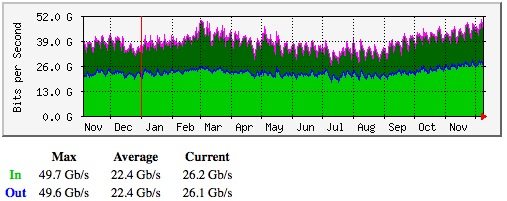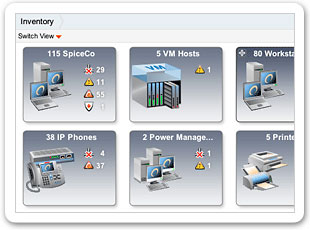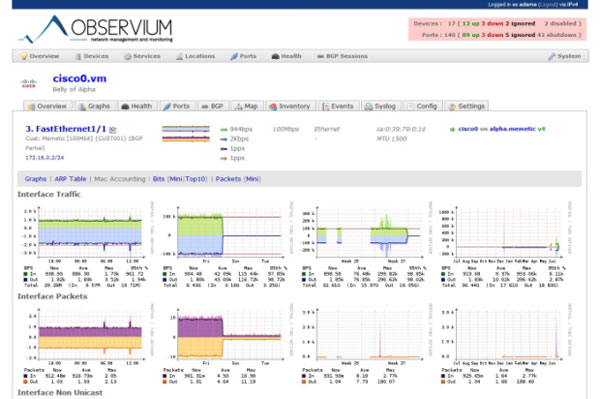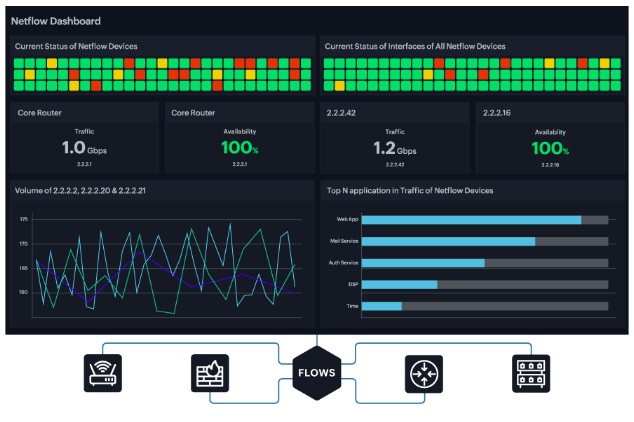5 useful network monitoring tools
The ability of the infrastructure to operate is the core to help the services of the business to take place continuously and the problems of operation will make it difficult for IT departments and it is difficult to solve . Fortunately, many free tools on the market today can monitor network performance and help identify problems before they arise.
1: Multi Router Traffic Grapher (MRTG)
MRTG is a network monitoring tool that has been around for a long time and provides basic but very useful information. Like all other tools in this article, MRTG collects information using SNMP (Simple Network Management Protocol) then displays the trends of the data. In Figure A , you can view the daily data of a router monitored by MRTG. Figure B shows a graph, showing the information collected within a year. This is the true power of these tools - they provide users with the data they need to make decisions for services and infrastructure.

Figure A: MRTG's daily data representation graph obtained.

Figure B: Use an annual data representation graph to plan long-term.
2: Cacti
First, let's talk a little bit about basic information. RRDTool is a tool created by programmers who created MRTG. RRDTool is designed for the general purpose of 'data logging capability works well and graphics for the entire system'. Basically, if you need a method to monitor something for a period of time, RRDTool is a reasonable choice.
So what will it do with Cacti? RRDTool is not really useful. It still needs some mechanism to collect data in the background that RRDTool uses to create graphics. Cacti is the peripheral system for RRDTool. It uses MySQL database to store the RRDTool information needed to create graphs. Cacti allows users to create data sources (usually SNMP connections to monitor devices), collect data from these devices, allowing users to group graphics like the system, giving management permissions for users for supervised data and many other features.
As with MRTG, Cacti gives users plenty of time to see the information collected. In Figure C , you can see that Cacti does a great job of displaying information trends in graph form. To the left of the display, see how Cacti allows you to group graphs to make things easier to find.
Cacti will require users to set up from scratch to use. You can speed up the deployment process by paying a small fee to download the pre-configured virtual computer from the JumpBox.

Figure C: Cacti will make managing graphs easier
3: PRTG (10 sensors free)
Provided by Paessler, PRTG (short for Paessler Router Traffic Grapher) provides a quick way to perform monitoring of devices connected to the network without requiring installation. PRTG also allows you to monitor other important systems, such as Exchange, SQL, VMware, and Windows, using Windows Management Instrumentation (WMI) and connecting to the vCenter host, ESX / ESXi.
QuanTriMang also has an overview article on Network Performance Testing with PRTG free version. This article contains a lot of screenshots of the PRTG tool.
PRTG is not completely free. Users can deploy the free version, but it is limited. You only get 10 sensors. In PRTG, sensor is a single monitoring component. You can use a sensor to monitor hard drives, other sensors to monitor RAM usage, another to monitor the total bandwidth in use, . and quickly take advantage of hundreds or thousands of sensors. It seems that this is a bit expensive, but it is a great choice to monitor what you need.
4: Spiceworks
Spiceworks has been around for a while. This is a comprehensive tool for group network monitoring, support, management of UPS (uninterruptible power supply), RFQ, computer assessment tool, online community, . Spiceworks has launched a network assessment and support system. It supports ads and is completely free. Users can join the extensive IT practitioners community to find solutions to emerging problems. At the time of writing, Spiceworks announced that it supports nearly 1.8 million IT professionals. This software has a fast installation speed on Windows computers.
A remarkable module in Spiceworks allows users to monitor network and system health. In Figure D , you can view a page of Spiceworks that displays the general health status of all devices.

Figure D: Spiceworks is a free application and very easy to install.
5: Observium
According to the Observium website: ' Observium is a network monitoring tool based on the ability to automatically detect PHP / MySQL / SNMP, including support for many network hardware and operating systems, including Cisco, Linux, FreeBSD, Juniper, Brocade, Foundry, HP, . '.
Observium software is quite popular. It provides a lot of information in a manageable way. If you are looking for an effective network management tool, download and use the Observium software. In addition, this software is completely free.
In Figure E , notice how the Observium moves all important information forward and in the middle. You can view current and previous information in a very readable format.

Figure E: Monitor bandwidth of Observium bandwidth
Other tools?
Site24x7 is agentless, SNMP-based network monitoring SaaS that helps you easily identify the root causes of the network performance issues by tracking key metrics, such as the CPU utilization, bandwidth usage, memory utilization, and response time. With Site24x7, you can monitor the in and out traffic, packets, errors, and discards and analyze network performance based on actionable insights using the health dashboard.
Site24x7 supports over 450 vendors, like Cisco, Canon, Juniper, D-Link, and Dell, and lets you monitor devices from other vendors by just entering the system object identifiers. View the network hierarchy and connections for all these devices using Topology Maps and Layer2 Maps and obtain instant alerts on their status changes using SNMP traps.

Site24x7 is a full-stack network monitoring platform that provides network performance monitoring, network traffic monitoring, and network configuration management—all from a single console—to help enterprises and SMBs stay on top of their remote and office networks.
You should read it
- Best SNMP monitoring software
- 5 best Cisco network device monitoring tools
- Comprehensive network monitoring tool set
- 5 best IT infrastructure monitoring tools
- 10 best IP monitoring tools
- Learn Pktmon: Windows 10's built-in network monitoring tool
- 6 leading Exchange Server monitoring software
- Hanoi Telecom launches an anti-network attack solution
May be interested
- Learn Pktmon: Windows 10's built-in network monitoring tool
 when it released its windows 10 october 2018 update, microsoft silently added an integrated command-line packet sniffer called pktmon to windows 10. since then, microsoft has added one more. number of features for this tool to make the user easier to use.
when it released its windows 10 october 2018 update, microsoft silently added an integrated command-line packet sniffer called pktmon to windows 10. since then, microsoft has added one more. number of features for this tool to make the user easier to use. - 3 best system monitoring tools for Ubuntu
 if you are using ubuntu, system monitoring tools will help detect any corrupted errors or services before they affect users.
if you are using ubuntu, system monitoring tools will help detect any corrupted errors or services before they affect users. - Hanoi Telecom launches an anti-network attack solution
 on august 6, vncs vietnam cybersecurity technology joint stock company (hanoi telecom) introduced a centralized monitoring solution (vncs web monitoring) to detect network attacks promptly and take real-time alerts.
on august 6, vncs vietnam cybersecurity technology joint stock company (hanoi telecom) introduced a centralized monitoring solution (vncs web monitoring) to detect network attacks promptly and take real-time alerts. - FireFox browser changes the logo on version 23
 in addition to changing brand identity, firefox also adds sharing features, blocking insecure content and the ability to monitor network traffic.
in addition to changing brand identity, firefox also adds sharing features, blocking insecure content and the ability to monitor network traffic. - Monitor and save Internet capacity on Windows 10
 windows 10 is universal operating system, it is used both on desktops, tablets and mobile phones. therefore, microsoft has built several data monitoring tools for users who are using limited capacity internet connection.
windows 10 is universal operating system, it is used both on desktops, tablets and mobile phones. therefore, microsoft has built several data monitoring tools for users who are using limited capacity internet connection. - 7 best network troubleshooting tools 'save' your home network
 do you often experience network problems? can not access? do you feel frustrated and want to connect as soon as possible? this article will help you diagnose network problems and offer windows built-in tools and a few third-party utilities to troubleshoot your network.
do you often experience network problems? can not access? do you feel frustrated and want to connect as soon as possible? this article will help you diagnose network problems and offer windows built-in tools and a few third-party utilities to troubleshoot your network. - 11 best MySQL monitoring tools for adjusting and managing SQL Server performance
 today, tipsmake.com will review the leading mysql (sql) software and performance management tools, helping you manage sql servers, as well as adjusting their performance and speed.
today, tipsmake.com will review the leading mysql (sql) software and performance management tools, helping you manage sql servers, as well as adjusting their performance and speed. - Best Linux monitoring tool & software
 like windows, the infrastructure that runs on linux must also be monitored, which is why today tipsmake.com summarizes the best monitoring tools and software available today.
like windows, the infrastructure that runs on linux must also be monitored, which is why today tipsmake.com summarizes the best monitoring tools and software available today. - Use Wireshark to analyze data packets in the network
 wireshark, also known as ethereal, this tool is probably not so strange to most of our users, which is considered one of the network data analysis applications, with monitoring and monitoring capabilities. real-time monitoring of packets, accurate display of user reports via the interface is simple and user-friendly.
wireshark, also known as ethereal, this tool is probably not so strange to most of our users, which is considered one of the network data analysis applications, with monitoring and monitoring capabilities. real-time monitoring of packets, accurate display of user reports via the interface is simple and user-friendly. - 6 leading Exchange Server monitoring software
 the following article will look at some of the best exchange server monitoring tools to help you monitor server health, mailbox size (mailbox), limits and more.
the following article will look at some of the best exchange server monitoring tools to help you monitor server health, mailbox size (mailbox), limits and more.










 10 indispensable efficient utilities for Firefox
10 indispensable efficient utilities for Firefox The percentage of people who quit using Windows XP was close to a record
The percentage of people who quit using Windows XP was close to a record Compare the performance of MongoDB and SQL Server 2008
Compare the performance of MongoDB and SQL Server 2008 What is new in Firefox 11?
What is new in Firefox 11? Microsoft introduced a 'refresh' feature on Windows 8
Microsoft introduced a 'refresh' feature on Windows 8 5 reasons to expect Windows 8
5 reasons to expect Windows 8